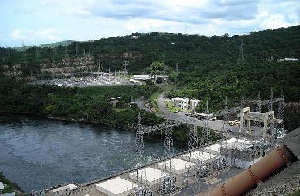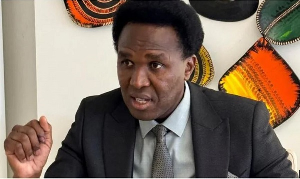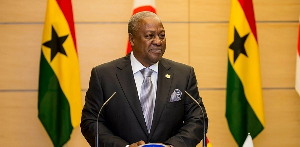Households and industries must brace up for gloomy days ahead, as available data on current power generation portend worsening power rationing over the next two years a result of challenges on the generation end of the supply chain.
Data shows a shortfall in power generation of about 300 megawatts as at January 27, 2015.
Poor rains over the past three years has led to a drastic reduction in hydro power generation from the Akosombo Dam, and unreliable thermal power generation using gas from Nigeria via the West African Gas Pipeline has had a terrible effect.
Surging domestic and industrial demand for electricity in Ghana increased to an all-time high of 12.38 percent in 2013, growing from the 2012 peak of 1,728.9 Megawatts (MW) to 1,942.9MW at the close of last year.
Over the last four years, however, the average year-to-year growth in demand for electricity has been about 10 percent.
The peak demand for 2011 was 1,664.3MW -- a 10.52 percentage growth over the 2010 demand of 1,505.9MW.
The estimated demand is growing and current projections indicate that the country’s requirements for electricity will hit 2,764.2MW this year.
For a country currently using under 2,000 megawatts of electricity, Ghana ought to be bringing on-stream 200 megawatts of new capacity every year. This additional capacity requires US$200million of investment.
An informed analysis of water inflow into the Akosombo Dam, which produces 1,020MW of the country’s total installed capacity of 2,846.5MW, has shown that the Akosombo Dam will record poor inflow of water over the next two years, which will lead to a shortfall in electricity generated from hydro.
Indeed, the projection has begun to manifest with a significant drop in the water level at the turn of the year -- forcing the power producer to shut down two units of the Akosombo Hydro Generating Station.
The Akosombo Hydro Generating Station, the largest hydro installation in the country, generates 1,020 Megawatts of power. Each of the installation’s six turbines generates 170MW of electricity. The shutting down of the two units means a shortfall of 340MW from Akosombo Generating station alone.
The Kpong Hydro Generating Station, which generates 160 MW from four installed units, has minimal storage capacity and is therefore operated in tandem with Akosombo as a run-of-the-river plant to optimise water use from the Volta Lake.
The minimum operating water level for the Akosombo Dam is pegged at 240 feet. However, the water inflow into the lake has recorded consistent reduction in year-end inflow since 2010 (see Figure 1).
The water level in the Akosombo reservoir on Monday was 256.38 feet. This dropped to 245.61 feet on Tuesday
Kirk Koffi, Chief Executive Officer of the Authority confirmed that the water inflow into the Akosombo reservoir “was not good last year and the year before. As we speak now, the level is very low and we are about six feet above the minimum level; so we have to manage the units at the Akosombo Dam and we will be running 4 machines instead of the six which are available”.
The Manager of System Control Centre at the Ghana Grid Company Limited (GRIDCo), Frank Otchere, speaking to Accra-based Joy FM said the new power-rationing table to be announced by the ECG "will probably tighten the schedule a little more than the current one".
There have been widespread unplanned power outages in various parts of the country, to the disgust of domestic consumers and industry alike.
There have been reported cases of electrical appliances malfunctioning, and patients -- particularly babies in incubators and others on life-saving machines on admission in hospitals --have had to bear the brunt of unplanned outages in the country.
Surgeries in major hospitals have had to be delayed as a result of the on-going power rationing.
Challenges with gas supply is the second major reason for the expected shortfall in power production. Natural gas is the most preferred source of fuel by producers due to the ease and savings made on maintenance.
The country requires an estimated 350million standard cubic feet of gas per day to power all installed thermal plants for power generation.
Presently, the main sources of gas for thermal power generation is Ghana’s own pumped to the Atuabo Gas Processing Plant by oil exploration company, Tullow, and Nigerian gas via the West Africa Gas Pipeline. Ghana Gas Company initially supplied about 60 MMscf/d of gas for thermal power generation at the VRA’s Aboadze power enclave. Ghana Gas has indicated its preparedness to supply the optimum 120 MMscf/d for power generation.
The expected contractual volume is 120 million standard cubic feet. However, supply of gas from NGas -- the VRA’s main supplier in Nigeria -- has been persistently unreliable within the last few months: falling from the expected 120 million cubic feet contractual volume to as low as 60 million cubic feet. NGas is made up of Chevron, Shell and the Nigerian National Petroleum Corporation (NNPC).
At present, an estimated 900MMscf/d of gas is required for use by the 3,000MW Thermal Plants in Nigeria. The Nigerian government also plans to increase its installed electricity generation capacity to 6,000MW. Granted that Ghana Gas supplies 120 Mscf/d of gas and NGas keeps up with its contractual obligation, there will still be a shortfall of 110 Mscf/d in gas supply for power production (see Figure 2).
Indeed, with the available installed power generation, the major challenge facing the country’s power sector is the fuel -- water, crude, gas -- to power all the available plants.
To bridge the shortfall in gas supply going forward, government yesterday signed a US$7billion agreement with energy firms ENI and VITOL for the supply of 170 million cubic feet of gas per day for the next 20 years from the gas field off Cape Three points. The project is expected to commence in 2017.
Click to view details



Business News of Wednesday, 28 January 2015
Source: B&FT
Power sector faces gloomy days
Entertainment
















